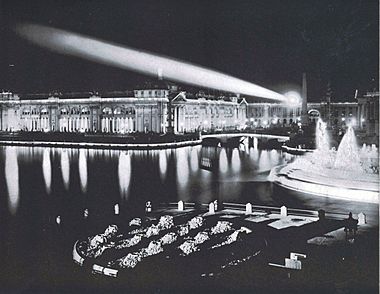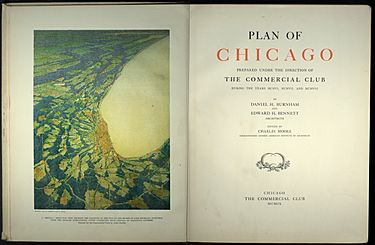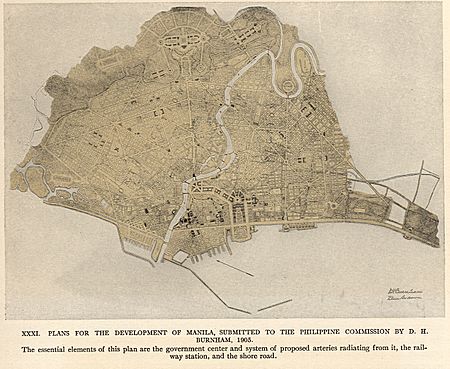Daniel Burnham facts for kids
Quick facts for kids
Daniel Burnham
|
|
|---|---|
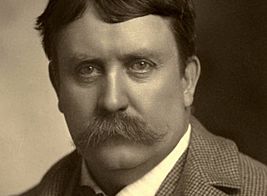
Burnham c. 1890
|
|
| Born |
Daniel Hudson Burnham
September 4, 1846 |
| Died | June 1, 1912 (aged 65) Heidelberg, Germany
|
| Occupation | Architect |
| Practice | Burnham and Root D. H. Burnham & Company |
| Buildings | Reliance Building, Flatiron Building, Union Station (Washington, D.C.), Ellicott Square Building |
| Projects | Plan of Chicago World's Columbian Exposition |
Daniel Hudson Burnham (September 4, 1846 – June 1, 1912) was a famous American architect and city planner. He was known for his grand designs and for helping to shape many American cities. He believed in the Beaux-Arts style, which used classical ideas from ancient Greece and Rome.
Burnham was the main person in charge of building the 1893 World's Columbian Exposition in Chicago, also called "The White City." He also created big plans for cities like Chicago, Manila, Baguio, and Washington, D.C.. He designed many famous buildings too, including the Flatiron Building in New York City and Union Station in Washington, D.C.
Even though he is famous for skyscrapers and city plans, a lot of his work involved designing buildings for shopping.
Contents
Early Life and Dreams
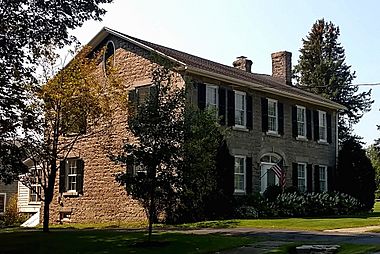
Daniel Burnham was born in Henderson, New York. His parents taught him the ideas of the Swedenborgian faith, which taught that people should always try to help others. When he was eight, his family moved to Chicago, where his father started a successful business selling medicines.
Daniel wasn't a great student, but he was very good at drawing. At 18, he tried to get into Harvard and Yale, but he didn't pass the tests. This was likely because he got very nervous during exams. In 1867, at age 21, he went back to Chicago. He started working as a draftsman for an architect named William Le Baron Jenney. Daniel quickly realized that architecture was what he wanted to do. He told his parents he wanted to be "the greatest architect in the city or country."
However, Daniel still loved to explore. In 1869, he left his job to go to Nevada with friends to look for gold, but they didn't find any. He even tried to get elected to the Nevada state government but lost. Broke, he returned to Chicago. He worked for another architect, L. G. Laurean. After the Great Chicago Fire in 1871, there was a lot of work for architects. But Daniel tried other jobs first, like selling glass and working in a drug store. He didn't stick with them for long, saying his family had "a tendency to get tired of doing the same thing for very long."
Starting a Career in Architecture
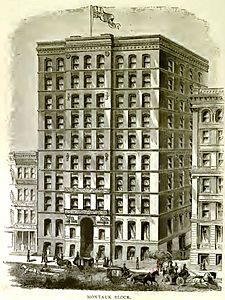
When Daniel was 26, he joined an architectural firm in Chicago. There, he met John Wellborn Root, who was four years younger. They became good friends and started their own architecture business, Burnham and Root, in 1873. This time, Burnham stayed with it, and their firm became very successful.
Their first big project was designing a mansion for John B. Sherman, who managed the huge Union Stock Yards in Chicago. Root created the first design, and Burnham made it better and watched over the building process. While working on the mansion, Burnham met Sherman's daughter, Margaret. They fell in love and married in 1876. Sherman then hired Burnham and Root for other projects, including the Union Stock Yard Gate, which is now a famous landmark in Chicago.
In 1881, their firm was asked to build the Montauk Building. This building became the tallest in Chicago at the time. Chicago's ground was very sandy and wet, so Root came up with a special "floating foundation." They dug down to a layer of hard clay and built a strong base of concrete and steel. This new foundation allowed them to build very tall buildings. The Montauk Building was so tall that people started calling such buildings "skyscrapers."
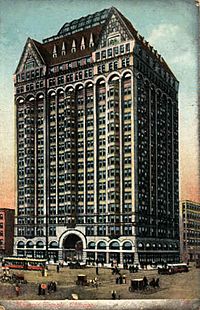
Burnham and Root went on to build more of America's first skyscrapers, like the Masonic Temple Building in Chicago. This building was 21 stories tall and was considered the tallest building of its time. It was later taken down in 1939.
Daniel Burnham and John Root had different but helpful skills. Root was great at creating beautiful designs and seeing the whole building in his mind. Burnham was excellent at finding clients and managing the building process. They both valued each other's work. Burnham also made sure their employees were happy. He put a gym in the office, gave fencing lessons, and let people play handball during lunch. Root, who played piano, would even give concerts in the office.
Even though they were very successful, they faced some problems. Their office building burned down in 1885, and a hotel they designed in Kansas City collapsed during construction in 1888. This made Burnham sad. They also lost a big project, the Auditorium Building, to another firm.
On January 15, 1891, while they were busy planning the World's Columbian Exposition, John Root suddenly died from pneumonia. He was only 41. Root's death was a huge shock to Burnham and to Chicago. After Root passed away, the firm changed its name to D.H. Burnham & Company. Burnham continued their success and started focusing more on city planning.
The World's Columbian Exposition: The White City
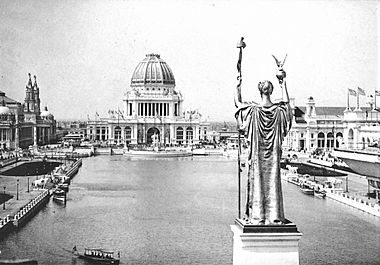
Burnham and Root had agreed to lead the design and building of the World's Columbian Exposition in Chicago. This was the biggest world's fair ever at that time (1893), celebrating 400 years since Christopher Columbus's voyage. After Root's death, Burnham worked with other famous architects and landscape designers, like Frederick Law Olmsted. They changed Root's original modern designs to a more classical style, known as Classical Revival.
To make sure the fair was a success, Burnham moved into a wooden building on the fairgrounds to be closer to the construction. Building the fair was very difficult. They faced money problems and had to finish everything very quickly to open on time.
The fairgrounds were like a dream city, with grand streets, classical buildings, and beautiful gardens. It was often called the "White City." This fair made the classical Beaux-Arts style very popular across the U.S. Many people wanted their buildings to look like those at the fair.
Burnham took strong control of the construction to make sure everything was finished. After the fair opened, Olmsted, who designed the fairgrounds, praised Burnham, saying he did an amazing job.
Building After the Fair
The success of the World's Fair greatly improved Burnham's reputation. Both Harvard and Yale gave him honorary degrees, which was a nice change from him failing their entrance exams years before. Many people thought Root was the artistic one and Burnham was just the business manager. But after Root's death, Burnham grew even more as an architect.
In 1901, Burnham designed the Flatiron Building in New York City. This was a groundbreaking building because it used a steel frame inside for support. The outside walls didn't hold up the building, which allowed it to be 22 stories tall. The design looked like a tall Renaissance palace, divided into three parts like a classical column.
Other famous buildings Burnham designed after the fair include:
- The Land Title Building (1897) in Philadelphia.
- John Wanamaker's Department Store (1902–1911) in Philadelphia, now Macy's.
- Wanamaker's Annex (1904) in New York City, a huge building with as much space as the Empire State Building.
- The neo-classical Gimbels Department Store (1908–1912) in New York, now the Manhattan Mall.
- The Mount Wilson Observatory in California.
- Filene's Department Store (1912) in Boston, his last major building design.
City Planning: Shaping the Future
In 1904, Burnham was asked by the Governor-General of the Philippines, William Howard Taft, to redesign Manila and plan a new summer capital in Baguio. Since the Philippines was a U.S. territory, Burnham could carry out his plans without needing local approval. He spent six months designing the project, with only six weeks in the Philippines. He focused on better sanitation, a consistent look for the buildings, and clear signs of government authority.
Burnham is most famous for his Plan of Chicago, which he created with Edward H. Bennett. Published in 1909, this plan showed how Chicago could grow in the future. It was the first complete plan for controlling the growth of an American city. It was part of the City Beautiful movement, which aimed to make cities more beautiful and organized. The plan included big ideas for the lakefront and river, and it said that every citizen should be close to a park.
Burnham imagined Chicago as a "Paris on the Prairie," with French-style public buildings, fountains, and wide streets leading from a central government building. Even though only parts of the plan were built, it set a high standard for city design. It helped people understand the need to plan for city growth and still influences Chicago today.
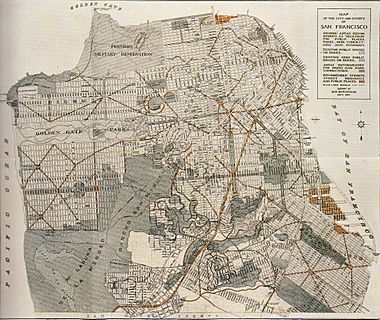
Burnham also helped plan other cities:
- Cleveland (1903)
- San Francisco (1905)
- Manila and Baguio in the Philippines (1905)
His plans for San Francisco were given to the city in 1905, but after the 1906 earthquake and fires, the city was rebuilt quickly, and Burnham's plans were not used. In the Philippines, his plan for Manila was not fully built because of World War II. However, some parts, like the shore road (now Roxas Boulevard) and the government buildings around Rizal Park, look like a smaller version of Washington, D.C.
In Washington, D.C., Burnham played a big role in the 1901 McMillan Plan. This plan helped complete the design of the National Mall. It suggested extending the Mall to a new Lincoln Memorial and a "pantheon" that later became the Jefferson Memorial. This plan involved reclaiming land from swamps and moving a train station, which was replaced by Burnham's design for Union Station. Because of his work, Burnham was made the first chairman of the United States Commission of Fine Arts in 1910, helping to make sure the McMillan Plan was followed. He served until his death in 1912.
Burnham's Impact and Legacy
After the World's Fair, Burnham became a leading supporter of the Beaux-Arts movement and the return of Neo-classical architecture. Much of his work was based on the classical styles of ancient Greece and Rome.
A famous quote by Burnham is: "Make no little plans. They have no magic to stir men's blood and probably will not themselves be realized." This saying shows his big-picture thinking and ambition.
At the start of the 20th century, Burnham was seen as the most important architect in America. He held many important positions, including president of the American Institute of Architects. Many other well-known architects started their careers working for him. His son, Daniel Burnham Jr., and grandchildren also became influential architects and planners.
Personal Life
Daniel Burnham married Margaret Sherman on January 20, 1876. They met while he was building her father's house. Her father even had a house built for the new couple. Daniel and Margaret were married for the rest of his life and had five children: two daughters and three sons. Their son, Daniel Burnham Jr., born in 1886, also became an architect and city planner. He worked in his father's firm and later directed the 1933-34 Chicago World's Fair.
The Burnham family lived in Chicago until 1886. Then, Daniel bought a large farmhouse and estate in Evanston, Illinois, near Lake Michigan. He felt Chicago was becoming too crowded and dangerous for his children. When he moved into a simple "shanty" at Jackson Park to oversee the World's Fair construction, his family stayed in Evanston.
Beliefs
Burnham was an early supporter of protecting the environment. He wrote that people had not been careful with natural resources, but they must be in the future to protect conditions for their children. He also thought cars would help the environment by ending horse-based transportation, making cities cleaner. Like many people of his time, he was interested in spiritual ideas and believed in a higher power.
Later Years and Death
In his fifties, Burnham's health began to worsen. He developed a condition called colitis and was diagnosed with diabetes in 1909. This affected his blood flow and led to a foot infection that lasted for the rest of his life.
On April 14, 1912, Burnham and his wife were traveling to Europe on the RMS Olympic. He tried to send a telegram to his friend Frank Millet, who was on the RMS Titanic traveling in the opposite direction. Burnham learned that the Titanic had sunk and his friend did not survive. Daniel Burnham died just 47 days later from his health problems and food poisoning in Heidelberg, Germany.
At the time of his death, D.H. Burnham and Co. was the largest architectural firm in the world. Even Frank Lloyd Wright, another famous architect who often disagreed with Burnham's style, admired him. Wright said Burnham was a "masterful" leader who promoted great building projects. Burnham was buried in Graceland Cemetery in Chicago.
Memorials and Tributes
Many places and awards are named after Daniel Burnham:
- Burnham Park and Daniel Burnham Court in Chicago.
- Burnham Park in Baguio, Philippines.
- Daniel Burnham Court in San Francisco.
- The annual Daniel Burnham Award for a Comprehensive Plan from the American Planning Association.
- The Burnham Memorial Competition in 2009 to create a memorial for him and his Plan of Chicago.
His papers, photos, and other materials are kept at the Ryerson & Burnham Libraries at the Art Institute of Chicago. The Reliance Building in Chicago, which Burnham and Root designed, is now called the Hotel Burnham.
Notable Buildings and Plans
-
Flatiron Building (1901)
-
Reliance Building (1890–1895)
-
Union Stock Yard Gate, Chicago (1879)
-
The Rookery Building in Chicago (1886)
-
Pennsylvania Union Station (1900–1902)
-
Union Station in Washington, D.C. (1908)
-
Gilbert M. Simmons Memorial Library, Kenosha, Wisconsin (1900)
-
Union Station, El Paso, Texas (1905–1906)
Buildings in Chicago
- Union Stock Yard Gate (1879)
- Montauk Building (1882–1883)
- Rookery Building (1886)
- Reliance Building (1890–1895)
- Monadnock Building (northern half, 1891)
- Marshall Field and Company Building (now Macy's, 1891–1892)
- Fisher Building (1896)
- Orchestra Hall (1904)
- Heyworth Building (1904)
Buildings in New York City
- Flatiron Building (1901)
- Wanamaker's Annex (1904, addition: 1907–1910)
- Gimbels Department Store (1908–1912)
Buildings in Philadelphia
- Land Title Building (1897)
- John Wanamaker's Department Store (now Macy's, 1902–1911)
Buildings in Washington, D.C.
- Union Station (1908)
- Postal Square Building (1911–1914)
- Columbus Fountain (1912)
Other Notable Buildings
- Ellicott Square Building, Buffalo, New York (1896)
- Columbus Union Station, Columbus, Ohio (1897)
- Gilbert M. Simmons Memorial Library, Kenosha, Wisconsin (1900)
- Union Station, El Paso, Texas (1905–1906)
- Selfridge & Co. Department Store, Oxford Street, London (1909)
- Filene's Department Store, Boston (1912)
- Mount Wilson Observatory, Pasadena, California
City Planning Projects
- City planning for Manila, Philippines
- City planning for Baguio, Philippines
- Plan of Chicago
- Cleveland Mall
- Plan for San Francisco (1905)
- McMillan Plan for Washington, D.C.
See also
In Spanish: Daniel Burnham para niños


